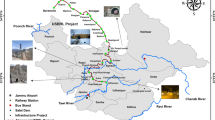Abstract
Increasing scope and complexity of construction industry, results into clashes of interests among the parties to the contract. Clashes lead to claims which may culminate into disputes. Project duration being considerable, escalation forms one of the reasons for occurrence of disputes. Dispute resolution consumes valuable time and money of the parties involved. Hence a faster, convenient and cheaper method needs to be evolved. This study throws light on the possibility of implementing neural networks in resolving disputes arising out of escalation claims. For this, factors influencing the decisions for escalation claims are identified and Neuro-solutions is implemented for network building. Various iterations help to assess the effect of change in network parameters. Comparison of their results is made in the study giving an optimum combination of parameters for effective resolution of escalation disputes using neural network. The approach is demonstrated to be a feasible alternative and the network is able to give a very high prediction rate.
Similar content being viewed by others
References
Arditi, D., Fatih E. Oksay, Tokdemir Onur B. (1998). “Predicting outcome of Construction litigation using neural network.” Journal of Computer Aided Civil & Infrastructure Engineering, Vol. 13, No. 2, pp. 75–81.
Arditi, D. and Patel, B. K. (1989). “Expert system for claim management in construction projects.” Journal of Project Management, Vol. 7, No. 3, pp. 141–146.
Chaphalkar, N. B. and Sandbhor, S. S. (2012). “Comparison of provision for escalation in various Indian construction contract forms.” Journal of Construction Engineering, Technology & Management (JoCETM), Vol. II, Issue 1, April 2012, pp. 1–11.
Chau, K. W. (2005) Predicting construction litigation outcome using particle swarm optimization, M. Ali and F. Esposito (Eds.): IEA/ AIE 2005, LNAI 3533, Springer-Verlag Berlin Heidelberg, pp. 571–578.
Chau, K. W. (2006). Prediction of construction litigation outcome-A case based reasoning approach, M. Ali and R. Dapoigny (Eds.), IEA/AIE, Springer-verlag Berlin Heidelberg, pp. 548–553.
Chau, K. W. (2007). “Application of PSO-based neural network in analysis of outcomes of construction claims.” Automation in Construction, Vol. 16, No. 5, pp. 642–646.
Enhassi, A., Mohamed, S., and Said El-Ghandour (2009). “Problems associated with the process of claim management in Palestine- Contractors’perspective.” Journal of Engineering, Construction and Architectural Management, Vol. 16, No. 1, pp. 61–72.
Hollman, J. and Dysert, L. (2007). Escalation estimation: Working with economics consultants, AACE International Transactions, pp. 1–6.
Iyer, K. C., Chaphalkar, N. B., and Patil S. K. (2012). “Use of artificial intelligence techniques for construction dispute resolution — An overview.” International Journal of Advances in Management, Technology & Engineering Sciences, Vol. I, Issue 6(II), pp. 115–120.
Iyer, K. C. and Kalidindi, S. N. (2002). “Final and binding power clauses in Indian construction contracts.” International Journal of Project Management, Vol. 20, No. 1, pp. 13–22.
Jeng, D. S., Cha, D. H., and Blumenstein, M. (2003). “Application of neural network in civil engineering problems.” Presented at the International Internet Processing Systems Interdisciplinaries (IPSI 2003) Conference, October 5-11, Seveti- Stefan, Montenegro, 20–3.
Khalaj, G., Nazari, A., and Pouraliakbar, H. (2013). “Prediction of martensite fraction of microalloyed steel by artificial neural networks.” Neural Network World, Vol. 23, No. 2, pp. 117–130.
Khoeini, M., Khalaj, G., and Khakian-Qomi, M. (2013). “ANN-based prediction of ferrite fraction in continuous cooling of microalloyed steels.” Neural Computing and Applications, Vol. 23, Nos. 3–4, pp. 769–777.
Muttil, N. and Chau, K. W. (2006). “Neural network and genetic programming for modelling coastal algal blooms.” International Journal of Environment and Pollution, Vol. 28, Nos. 3–4, pp. 223–238.
Petroutsatou, K., Georgopoulos, E., Lambropoulos, S., and Pantouvakis, J. P. (2011). “Early cost estimating of road tunnel construction using neural networks.” Journal of Construction Engineering & Management, Accepted Aug. 31, 2011, posted ahead of print Sept 2, 2011.
Pouraliakbar, H., Khalaj, G., Mamaghani, K. R., and Khalaj, M.-J. (2013). “Modeling the correlation between heat treatment, chemical composition and bainite fraction of pipeline steels by means of artificial neural networks.” Neural Network World, Vol. 23, No. 4, pp. 351–368.
Rajasekaranm, S. and G. A. Pai (2003). Neural network, fuzzy logic and genetic algorithm-synthesis and application, Prentice Hall of India Publications Delhi, India.
Shahin, M., Mark B. Jaska, and Maier, H. R. (2001). “Artificial Neural Network applications in geotechnical engineering.” Journal of Australian Geomechanics, Vol. 36, No. 1, pp. 49–62.
Taormina, R., Chau, K. W., and Sethi, R. (2012). “Artificial neural network simulation of hourly groundwater levels in a coastal aquifer system of the Venice lagoon.” Engineering Applications of Artificial Intelligence, Vol. 25, No. 8, pp 1670–1676.
Theresa, M. M. J. and Raj, V. J. (2011). “Analogy making in criminal law with neural network.” Emerging Trends in Electrical and Computer Technology (ICETECT), 2011, IEEE Publications, pp. 772–775.
Wu, C. L., Chau, K. W., and Li, Y. S. (2009). Predicting monthly streamflow using data-driven models coupled with data-preprocessing techniques, Water Resources Research, 45: W08432 2009.
Zhou, G., Deng, P., Xun, X., and Yaqub, R. (2010). “Innovative ANN technique for predicting failure/ cracking load of masonry wall panel under lateral load.” Journal of Computing in Civil Engineering, ASCE, Vol. 24, No. 4, pp. 377–387.
Author information
Authors and Affiliations
Corresponding author
Rights and permissions
About this article
Cite this article
Chaphalkar, N.B., Sandbhor, S.S. Application of neural networks in resolution of disputes for escalation clause using neuro-solutions. KSCE J Civ Eng 19, 10–16 (2015). https://doi.org/10.1007/s12205-014-1161-3
Received:
Revised:
Accepted:
Published:
Issue Date:
DOI: https://doi.org/10.1007/s12205-014-1161-3




